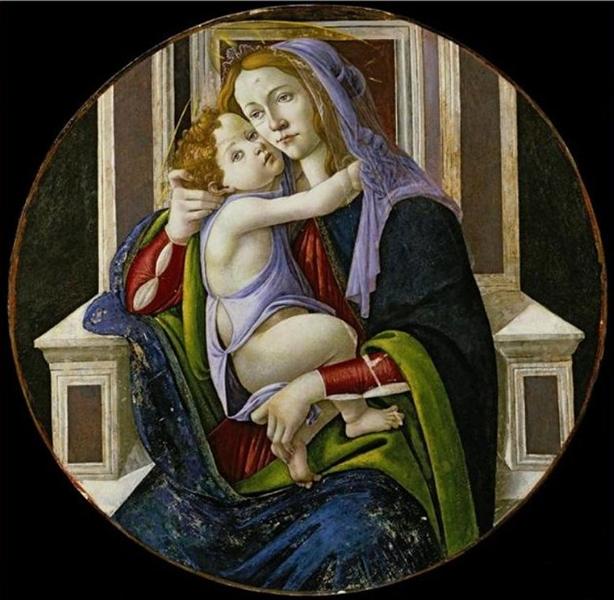Beskrivelse
Sandro Botticelli's 1510 painting "The Madonna and Child" is a work that encapsulates the essence of the Renaissance, a period in which the artist flourished and left an indelible mark on art history. This piece, although less iconic than some of his more recognizable works such as "The Birth of Venus" or "Primavera", stands with dignity for its deep emotional expression and refined technique.
Looking at the composition, one can see how Botticelli employs an intimate approach in his depiction of the Virgin Mary and the Christ Child. The figure of the Virgin is one of a serenity that transcends time, framed by a rich background that contrasts with the soft tones of her clothing. Mary is presented in an almost devout attitude, with her face slightly tilted towards her son, creating a visual connection that emanates warmth and tenderness. The Child, on the other hand, is portrayed with a childlike posture that conveys not only his vulnerability, but also an innocence that evokes the purity of his divinity.
The use of colour is masterful; the soft blues and pinks that predominate in Mary's clothing enhance her figure and suggest an almost ethereal luminosity. Botticelli, known for his delicate palette and his ability to create an almost painterly effect, uses these hues to emphasise the heavenly importance of the Mother and Child. The background, composed of warm hues that blend into a barely defined landscape, contributes to an almost calm atmosphere, allowing the central figures to be the true focus of attention.
An interesting aspect of this work is its representation of the maternal bond. The Virgin's gaze, both sweet and melancholic, invites contemplation and reminds us of the fundamental role she plays in the history of Christianity. This relationship between mother and child has been a recurring theme in the painting of the period, but Botticelli manages to infuse his own sensitivity into the representation, endowing the image with a subtle drama that invites reflection.
Although The Madonna and Child is not as well known as other works of its time, its oil technique and treatment of textures are worthy of further exploration. Botticelli, whose artistic training was influenced by the classical ideal of beauty and the humane doctrines of his time, captures the aesthetics of the Renaissance in every fold of the garment and in the softness of each figure's face. His style is characterized by elegant lines and balanced composition, conveying a sense of harmony and serenity.
The work is situated within a broader artistic context, where the Virgin Mary is a powerful symbol. The Renaissance was notable for its revalorization of the female figure in religious painting, and Botticelli, with his distinctive poetic touch, contributed to this artistic revolution. The work shares visual echoes with other works of his time, such as Raphael's Madonnas, although Botticelli subtly moves away from excessive idealism, preferring a representation that combines the sacred with the human.
Ultimately, The Madonna and Child is not only a testament to Botticelli's genius, but also an enduring representation of the devotion that has inspired generations. His ability to emotionally connect with the viewer through his art resonates even today, reminding us of the beauty that can be derived from the silent contemplation of sacred images. Through this work, Botticelli continues to invite us to reflect on the relationship between the divine and the human, making this painting a valuable example of his contribution to Renaissance art.
KUADROS ©, a famous painting on your wall.
Hand-made oil painting reproductions, with the quality of professional artists and the distinctive seal of KUADROS ©.
Painting reproduction service with satisfaction guarantee. If you are not completely satisfied with the replica of your painting, we will refund 100% of your money.

